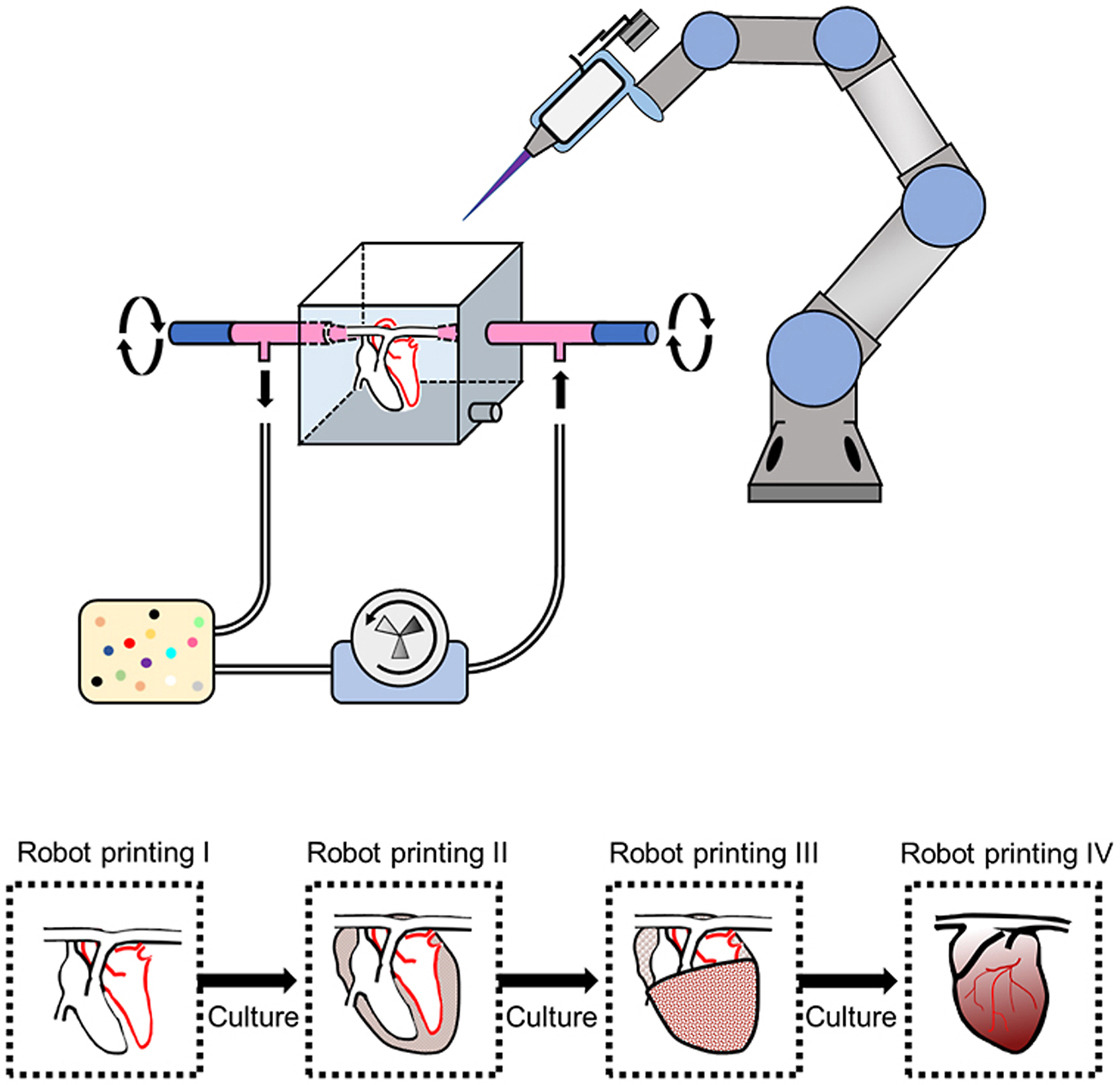Researchers from theChinese Academy of Sciences(CAS)有一个基础机械手臂转换为3D bioprinter capable of printing cells from all directions.
Using the modified bioprinter, the researchers were able to fabricate a complex-shaped blood vessel scaffold without causing cell damage or preventing cell growth and function, which are common challenges to current bioprinting methods. The 3D printed vascularized cardiac tissue remained alive and beating for six months, and could demonstrate a feasible method of bioprinting functional tissues and organs in the future.
The team also designed a repeated print-and-culture bioprinting strategy that could generate complex tissues or organs containing blood vessel networks capable of maintaining long-term survival and key functions in the future.

3D bioprinting tissues
Over the past decade, there has been significant progress made in the development of viable patient-specific tissues by means of 3D bioprinting technologies. While fully printed organs still remain some way off, several bioprinting firms and research teams have taken notable strides in the right direction.
3D printer manufacturer3D Systems, for instance, isexpanding its bioprinting programafter acquiring bioprinting technology developerVolumetric biotechnologies, while bioprinting start-upBrinteris seeking toopen up the accessibility of bioprintingwith its new entry-level 3D printer, the Brinter Core. Elsewhere, regenerative medicine companyCTIBIOTECHhas unveiled anew 3D bioprinting platformto deliver personalized medicine for patients with colon cancer.
There have also been regulatory advances in the bioprinting space, with BICO recently being granted two new patents for 3D printing temperature-sensitive bioinks, and regenerative medicine firmMatricelflicensingTel Aviv University’spatent-pending3D bioprinting technology for organ and tissue implants. Most recently, bioengineering start-upTrestle Biotherapeuticsgained a license for anew 3D bioprinting technologythat enables the fabrication of functional human kidney tissues.
Other recent regenerative medicine breakthroughs includenew bioinks specifically for bioprinting blood vessels, the successful3D printing of living brain cells, and a new volumetric 3D printing process capable of fabricatingfunctional bioprinted livers.

The novel bioprinting platform
在最新的研究中,中科院的研究人员to overcome current challenges surrounding the incorporation of blood vessel networks during the bioprinting process. Most current technologies rely on immobilizing printed cells by adding artificial biomaterials to the bioinks, which can inhibit cell functionality and the formation of new blood vessels. This in turn reduces the biological function of the printed structure and its long-term survival.
The team started by converting a six-axis robotic arm into a 3D bioprinter to enable cell printing from all directions. To avoid to solidification of biomaterials, the researchers also designed an oil bath-based cell printing system that transforms the printed cells into blood vessel scaffolds by means of hydrophobicity, or the process of repelling water. This meant that the blood vessel scaffolds better maintained their cell activity while also promoting the formation of cell-to-cell contact.
The team used their converted bioprinter and oil bath to design a repeated print-and-culture bioprinting strategy, inspired by natural organ developmental processes. They printed mono and multilayered cells onto the blood vessel scaffold which were cultured for certain intervals in order to induce the formation of cell-to-cell contact and the growth of new blood vessels. Then, the scaffold and already printed cells were subjected to a new round of bioprinting.

Bioprinting a beating heart
The researchers believed that, in theory, their print-and-culture process could enable the fabrication of functional complex tissues and even full organs which are connected with blood vessel networks and able to survive for long periods of time.
The team proved their idea by 3D printing a piece of vascularized cardiac tissue that maintained rhythmic beating and was classed as “alive” for at least six months. They then established a two-robot platform in order to achieve simultaneous bioprinting of multiple types of cells on complex-shaped blood vessel scaffolds.
Going forwards, the researchers believe their novel bioprinting platform offers a potential new strategy to fabricate large-scale and functional artificial tissues and organs in an in vitro environment.
More information on the study can be found in the paper titled:“A multi-axis robot-based bioprinting system supporting natural cell function preservation and cardiac tissue fabrication,”published in the Bioactive Materials journal. The study is co-authored by Z. Zhang, C. Wu, C. Dai, Q. Shi, G. Fang, D. Xie, X. Zhao, Y. Liu, C. Wang, and X. Wang.
Subscribe to the3D Printing Industry newsletterfor the latest news in additive manufacturing. You can also stay connected by following us onTwitterand liking us onFacebook.
Looking for a career in additive manufacturing? Visit3D Printing Jobsfor a selection of roles in the industry.
Subscribe to ourYouTube channelfor the latest 3D printing video shorts, reviews and webinar replays.
Featured image showsthe CAS researchers’ novel bioprinting platform. Image via Bioactive Materials.


